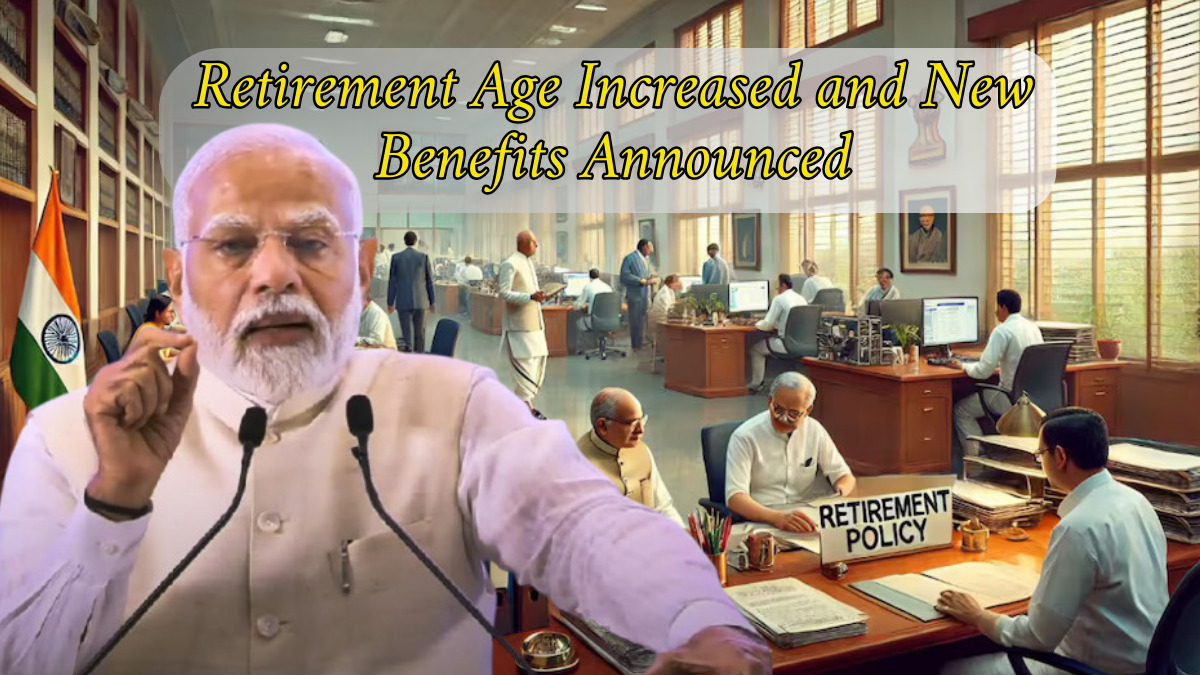In a landmark decision, the government has officially increased the retirement age and introduced multiple new benefits for Class 2 and Class 3 government employees, effective immediately. This move aims to strengthen the financial security, career prospects, and post-retirement life of millions of public sector workers. Let’s explore the detailed changes and their implications.

Table of Contents
Short Summary: Retirement Age Increase and New Benefits

Category |
Details |
|---|---|
Retirement Age |
Increased from 60 years to 62 years |
New Benefits |
Higher PF contributions, enhanced medical coverage, extended housing, more leave |
Effective Date |
Today |
Applicable To |
Class 2 and Class 3 Government Employees |
Official Website |
Retirement Age Increase: Major Relief for Employees
One of the most awaited announcements is the hike in the retirement age for Class 2 and Class 3 government employees.
- New Retirement Age: Increased from 60 years to 62 years.
- Service Extension: Employees now enjoy two extra years of service.
- Financial Planning: More time to build savings and pension funds.
- Higher Gratuity: Extended service leads to better gratuity payouts.
- Promotions: Greater chances of reaching senior positions.
- Uniform Application: Applies across all departments without exceptions.
This change reflects a recognition of increased life expectancy and the growing importance of experienced personnel in the public system.
New Benefits Introduced for Class 2 and Class 3 Employees
Alongside the retirement age extension, several valuable benefits have been launched:
- Higher Provident Fund Contributions: Increased by 2%.
- Enhanced Medical Coverage: Full post-retirement coverage up to ₹5 lakh.
- Additional Annual Leave: From 30 to 36 days per year.
- Skill Development Courses: Open enrollment for those nearing retirement.
- Financial Support for Entrepreneurship: Special assistance programs.
- Increased Family Pension: Enhanced by 10%.
- Extended Housing Facility: Retirees can retain housing for one additional year.
These measures aim to provide better financial, health, and skill security for employees both during and after their service.
Summary of Key Changes
Aspect |
Old Policy |
New Policy |
Effective Date |
Applicable To |
Retirement Age |
60 Years |
62 Years |
Today |
Class 2 and Class 3 Employees |
Provident Fund Contribution |
Standard Rate |
Increased by 2% |
Today |
All Eligible Employees |
Medical Insurance Post-Retirement |
Limited Coverage |
Full Coverage up to ₹5 lakh |
Today |
Retirees |
Annual Leave |
30 Days |
36 Days |
Today |
Active Employees |
Family Pension |
Basic Rate |
Increased by 10% |
Today |
Family of Retirees |
Housing Facility |
Till Retirement |
Till Retirement + 1 Year |
Today |
Retirees |
Skill Development Opportunity |
Selective |
Open to All Nearing Retirement |
Today |
All Employees nearing retirement |
How Employees Will Benefit Financially
The financial gains from these changes are substantial:
- Higher Pension Corpus: Two additional years of contributions mean a larger retirement fund.
- Increased Gratuity: Extended service leads to higher payouts.
- Extended Savings Period: More time to invest and save.
- Entrepreneurship Support: Subsidized loans for post-retirement businesses.
Financial Impact Table
Parameter |
60 Years Retirement |
62 Years Retirement |
Pension Corpus (Approx.) |
₹45 lakh |
₹52 lakh |
Gratuity Amount (Approx.) |
₹20 lakh |
₹24 lakh |
Provident Fund Savings |
₹25 lakh |
₹30 lakh |
Total Retirement Savings |
₹90 lakh |
₹1.06 crore |
Impact on Promotions and Career Growth
The policy change is not just about retirement — it also opens new career growth opportunities:
- More Promotions: Employees have more time to attain senior positions.
- Skill Upgrades: Wider access to training and professional development programs.
- Management Grooming: Smoother succession planning for leadership roles.
Promotion and Career Growth Benefits
Opportunity |
Before Change |
After Change |
Chances of Promotion |
Limited |
Extended |
Access to Skill Development |
Selective |
Widespread |
Average Final Position Attained |
Mid-level |
Senior-level |
Important Points to Remember
- The policy is effective immediately from today.
- Employees reaching 60 years this year will automatically benefit.
- No separate application is required for retirement extension.
- Salary revisions and pension calculations will reflect the new benefits.
- Employees should revise their retirement planning to adapt to the changes.
FAQs About Retirement Age Increase and New Benefits
Q1. What is the new retirement age for Class 2 and Class 3 government employees?
Ans. The retirement age has been increased from 60 to 62 years.
Q2. Are new benefits applicable to current employees or only new recruits?
Ans. The benefits apply to all eligible current Class 2 and Class 3 government employees.
Q3. Is there any need to apply separately for retirement age extension?
Ans. No, the extension is automatic and department heads will update records accordingly.
Q4. What changes have been made in medical benefits?
Ans. Medical coverage post-retirement is now fully extended up to ₹5 lakh.
Q5. Will the new benefits impact salary structures immediately?
Ans. Yes, salary revisions reflecting these changes will be implemented from the next salary cycle.
Q6. What kind of skill development opportunities will be available?
Ans. Government-sponsored courses on management, IT, finance, and leadership will be accessible to employees nearing retirement.
Q7. Will family pensions increase too?
Ans. Yes, family pensions will be enhanced by 10% as part of the new policy.
Q8. Is there any change in housing facilities for retiring employees?
Ans. Retirees will now be allowed to continue using housing facilities for one additional year after retirement.
Q9. Where can I find official updates about this policy?
Ans. Official updates are available at the Government Portal.
Conclusion
The government’s move to raise the retirement age and introduce comprehensive benefits marks a new era for Class 2 and Class 3 government employees. It reinforces financial security, values long-term service, and promotes post-retirement entrepreneurship and well-being. Employees are encouraged to leverage the extra years of service and new benefits to secure a prosperous and stable future.
The information provided is based on the latest government notification. Future updates or circulars may bring additional changes. Employees should consult their HR departments for personalized advice.




